|
MORE PIRATE STUFF... A Brief History of Piracy How long has piracy been prevalent? As long as civilization has existed. The earliest records show pirates in ancient Greece. Since the Aegean Sea was the epicenter of Greece, it soon became infested with pirates. The Greeks were the first to define these sea robbers as pirates or pe´irates. Piracy was such a problem that the ruler of Greece, Alexander the Great, made it his mission to end piracy. Legend has it that when he asked one captured pirate his reason for being a sea robber, the pirate said “The same reason as you have for troubling the whole world. But since I do it in a small ship, I am called a pirate. Because you do it with a great fleet, you are called an emperor.” Roman leader, Julius Caesar, was kidnapped by pirates. He was on his way to Rhodes when pirates took his ship and held him captive on a remote island for nearly six weeks before his ransom was paid. These scalawags were troublesome in northern Europe, as well. Viking pirates sailed the North Sea from the 8th century to the mid-12th century. They were considered to be brutal and merciless. Piracy was a problem everywhere, but for different reasons. Some men turned to piracy out of desperation, unable to earn a living any other way. Some men became pirates to escape slavery or criminal prosecution or religious persecution. On the North African coast, pirates were called Barbary corsairs. Unlike most other pirates, they weren’t searching for riches. They sought Christian sailors for slavery. Barbary corsairs, unlike other pirates, didn’t sail for more than a few weeks at a time. This is because the ships were loaded down with slaves and food and water, which only lasted the many men aboard a few weeks. The Christian slaves endured terrible conditions, including hunger, beatings, and crowded conditions. There were privateers too, who were nothing more than commissioned pirates. Monarchies allowed “legalized” piracy to help finance wars, such as the War of Spanish Succession (also known as Queen Anne’s War), King George’s War, Quasi War, and Nine Years War. This meant that privateers were allowed to attack and plunder enemy ships, but they often attacked non-enemy vessels too if they thought there was good booty aboard. Soon after the New World was discovered, piracy came to America. Spanish pirates, called conquistadors plundered the Spanish Main. This consisted of Central and South America, as well as the Caribbean. After Christopher Columbus discovered the New World, privateers and pirates waited along the coast of North America for Spanish ships full of treasure on their way home to Spain. As the New World grew and trade expanded, so did piracy. The heyday of piracy was the Golden Age of Piracy, which many define as lasting from the mid-1600s until circa 1730. It began when most of Europe were involved in the “Wars of Religion” and is considered to be 1650 – 1680. Some have dubbed this “the buccaneering era.” Next came “the pirate round,” lasting from the last 1600s until about 1700. India was faring far better economically than Europe during this time (look no farther than the Great Mogul and East India Company for proof of this), so pirates hit the Indian Ocean to plunder ships loaded with fine fabrics, coffee, tea, gold, gems, and much more. The early 1700s was the last era of the Golden Age of Piracy. After all the “Wars of Religion” had ended, thousands of seamen (privateers) were suddenly out of work. It wasn’t a stretch for these men to turn to piracy since they had been doing it all along with the Crown’s blessing. As trade increased between Europe, Africa, and North America, especially in the Caribbean, so did piracy. Sugar, tobacco, coffee, cocoa, rum, and slaves brought good money.
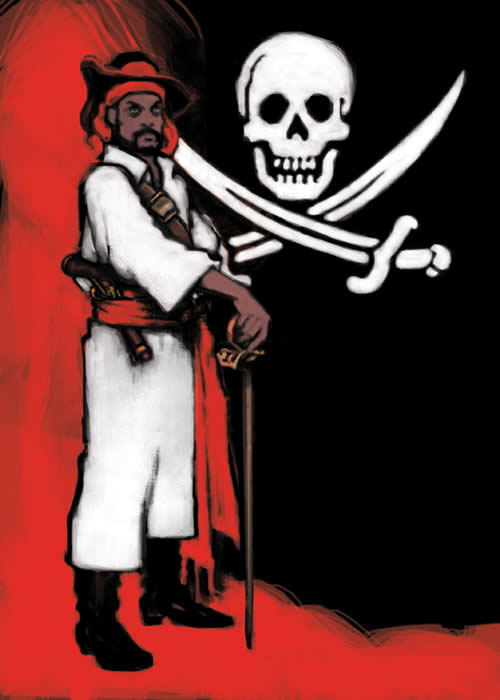
Favorite Pirate Party Places The three biggest pirate hang outs were Madagascar, Port Royal, and Nassau, on the island of New Providence in the Bahamas. Madagascar is an island off the African coast in the Indian Ocean. Back in the day, it was uncolonized, which meant it was safe for pirates. Just to be safe, however, pirates built a fort. The Bahamas was considered “pirate central” for a long time before Woodes Rogers was sent to eradicate piracy. At the height of piracy, there were close to fifty tavern keepers, 2,000 buildings, and 6,500 residents in Port Royal. It was a fun, thriving place until it was destroyed by an earthquake in 1692.
Piracy Today Aren’t pirates a thing of the past? No way! Piracy is an epidemic with no end in sight. During the last few years, piracy has more than doubled. Today, the sea robbers aren’t as dashing and dapper as Calico Jack Rackham and Blackbeard. They are warlords and terrorists. They have sophisticated GPS equipment, weapons, and sleek, fast boats. The most dangerous waters are off the coast of Somalia. Also, the Strait of Malacca, Arabian Peninsula, India, Bangladesh, West Africa, Brazil, Venezuela, and Columbia are heavily infested with modern day pirates. One of the problems is that legitimate military are moonlighting as pirates. Also, these pirates are well-funded and organized since they are part of major crime syndicates. A new trend is pirates attacking private vessels, such as yachts and cruise ships. They use the hostages to get huge ransoms. Additionally, piracy is often not reported because it is bad for business. Customers might take their business elsewhere if they feel their cargo is not safe. Insurance premiums will likely increase, just like car and home insurance, when claims are filed. Some experts estimate that only a tiny fraction of piracy is reported. Only one percent or so of pirates are caught and prosecuted! Lastly, since these are international waters, it is hard to determine jurisdiction and it usually turns political. Enough said. Can anything be done about it? The International Maritime Bureau (www.icc-ccs.org) was established to combat piracy. Ship captains are urged to report suspicious activity and also to report if they are in distress. They have a 24-hour reporting centre. Advisories are then given so that other ships will avoid trouble spots. Traveling at night is discouraged in some places and so is traveling closer than fifty nautical miles to the shoreline. Arming the crew has been discussed but is widely discouraged. However, trained personnel, such as former military and Israeli special forces are hired by some ships and have been effective in discouraging piracy. The ships are being armed with cool devices, such as invisible fences that will shock anyone trying to climb aboard, GPS alarm systems, lockdown devices, and high pressure water hoses to blast unwanted visitors! Unmanned drones are used to many pirate-infested waters and to investigate a suspicious ship.
Famous Pirates and Privateers Legend has it the Eustace “the Black Monk, had a deal with the devil so that his ship could become invisible when necessary. However, he was caught during a battle with the Royal Navy and beheaded. You just can’t trust the Devil! Francis Drake was a privateer and explorer. He was so successful that Queen Elizabeth I knighted him in 1581. Sir Walter Raleigh was an explorer and navigator who became a privateer to finance his expeditions, including his voyages to the New World. Jean Lafitte was a little bit of everything: privateer, smuggler, slaver, pirate, and war hero. Lafitte fought to protect New Orleans during the War of 1812. Bartholomew “Black Bart” Roberts reportedly seized close to 500 ships, including the Sagrada Familia. The ship was loaded with diamonds, coins, and many other valuable goods. Captain Kidd was a merchant, family man, churchgoer, and pirate. He struck a deal with the Lords Proprietors to capture some pirates and attack enemy ships. However, he went from privateer to pirate during his three-year voyage and was hanged for his actions. Blackbeard was one of the most colorful buccaneers and probably the most widely known. He began as a privateer and later turned to piracy. The fearless sea robber was beheaded during battle with the Royal Navy off the coast of North Carolina. Madame Cheng took over her husband’s small fleet upon his death. She turned it into an empire, controlling the South China Sea with roughly 1,800 ships and 80,000 pirates! Anne Bonny “divorced” her husband to run away with pirate captain, “Calico Jack” Rackham. She pretended to be a man so that she would be accepted on the pirate ship. Mary Read dressed as a man to join the military, where she met her husband. She became a pirate after his death due to financial struggles and boredom. Alwilda, a Swedish princess, reportedly became a pirate to avoid an arranged marriage to a Danish prince. She is believed to be one of the first female pirates and she sailed with an all female crew. Charlotte De Berry dressed as a man so that she could be with her husband, who was a sailor. He was accused of mutiny by an officer who reportedly found out Charlotte was a woman and wanted her for himself. Charlotte’s husband was found guilty and flogged to death. When Charlotte and the rest of the crew were later captured by pirates, she led the mutiny and successfully took over the ship. Under her command, the crew became pirates and sailed the waters around Africa plundering many ships laden with treasure. Many believe this is a fictional story and there was no Charlotte De Berry.
Grace O’Malley attacked ships off the coast of Ireland and amassed a fortune through prudent ventures and piracy. She considered herself the Queen of Ireland so she refused to bow when introduced to Queen Elizabeth I. She arranged the meeting to get help with her sons who were in trouble. It is said that Queen Elizabeth I was quite impressed with O’Malley’s accomplishments and her knowledge of Latin, that she did help her.
|


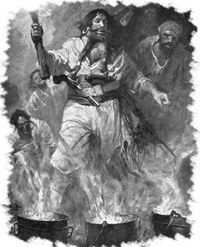 Have you always thought that being a pirate sounded pretty cool? Well, there are some things you need to know before you decide to quit your job and steal a boat. For starters, you’ll be called all kinds of names, such as a sea robber, rogue, corsair, buccaneer, sea dog, scalawag, picaroon, sea villan, swashbuckler, and sea marauder.
Have you always thought that being a pirate sounded pretty cool? Well, there are some things you need to know before you decide to quit your job and steal a boat. For starters, you’ll be called all kinds of names, such as a sea robber, rogue, corsair, buccaneer, sea dog, scalawag, picaroon, sea villan, swashbuckler, and sea marauder. 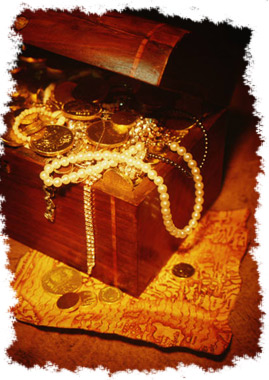 What did pirates consider to be good booty? Why, anything they could eat or sell or use, silly! This included fine fabrics from merchant ships carrying delicate hand-woven linen and silks from the Far East, snuff, tobacco, pipes, weapons, ammunition, food (especially sugar and coffee and exotic spices), rum, wine, ale, goblets, medicine, pieces-of-eight, doubloons, gold bars, silver, jewelry (including ornate crucifixes!), gems, precious metals, candlesticks, silverware, or anything of value like an antique jewelry box or snuff box. Often, the ship was seized and its crew forced to become pirates. If the ship was of no use or too recognizable, it was raided (sails, guns, ropes, etc.) and then sunk to get rid of any evidence of piracy.
What did pirates consider to be good booty? Why, anything they could eat or sell or use, silly! This included fine fabrics from merchant ships carrying delicate hand-woven linen and silks from the Far East, snuff, tobacco, pipes, weapons, ammunition, food (especially sugar and coffee and exotic spices), rum, wine, ale, goblets, medicine, pieces-of-eight, doubloons, gold bars, silver, jewelry (including ornate crucifixes!), gems, precious metals, candlesticks, silverware, or anything of value like an antique jewelry box or snuff box. Often, the ship was seized and its crew forced to become pirates. If the ship was of no use or too recognizable, it was raided (sails, guns, ropes, etc.) and then sunk to get rid of any evidence of piracy. 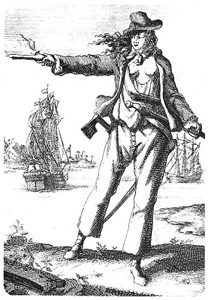 Those of the female persuasion might be wondering if there were women pirates? You bet! Two of the best pirates of all time were women: Anne Bonny and Mary Read (and discussed in
Those of the female persuasion might be wondering if there were women pirates? You bet! Two of the best pirates of all time were women: Anne Bonny and Mary Read (and discussed in 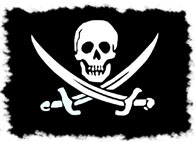 Pirate flags were used to identify a particular captain. The flags had designs, such as a skull and crossbones or a cutlass or hourglass or a skeleton or devil. These symbols represent power and death. These flags, also called Jolly Rogers, were sometimes hidden until a pirate ship got close to the merchant ship it planned to attack and then it ran up its ‘colors’ to let the other captain and crew know that they were in big trouble! Sometimes the sight of a pirate flag was enough to elicit a surrender. According to my research, it is unlikely that Blackbeard had to fight much once his reputation was well known. What would your design be?
Pirate flags were used to identify a particular captain. The flags had designs, such as a skull and crossbones or a cutlass or hourglass or a skeleton or devil. These symbols represent power and death. These flags, also called Jolly Rogers, were sometimes hidden until a pirate ship got close to the merchant ship it planned to attack and then it ran up its ‘colors’ to let the other captain and crew know that they were in big trouble! Sometimes the sight of a pirate flag was enough to elicit a surrender. According to my research, it is unlikely that Blackbeard had to fight much once his reputation was well known. What would your design be? But as the captain, you would get to decide the Code of Conduct on your ship. Yes, even nefarious pirates had rules to live by and they varied according to the captain. For example, most forbid fighting on board. A few banned drinking (okay, not many). No man shall desert during battle was a standard rule. If injured in battle, certain compensation was guaranteed, depending on whether a leg (perhaps 500 silver pieces) or eye (say maybe 100 pieces of silver) was lost.
But as the captain, you would get to decide the Code of Conduct on your ship. Yes, even nefarious pirates had rules to live by and they varied according to the captain. For example, most forbid fighting on board. A few banned drinking (okay, not many). No man shall desert during battle was a standard rule. If injured in battle, certain compensation was guaranteed, depending on whether a leg (perhaps 500 silver pieces) or eye (say maybe 100 pieces of silver) was lost. 
